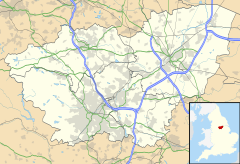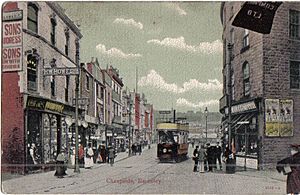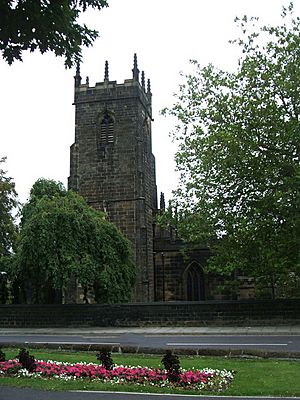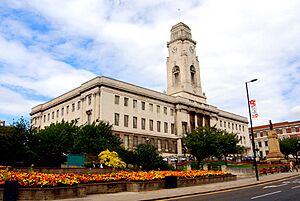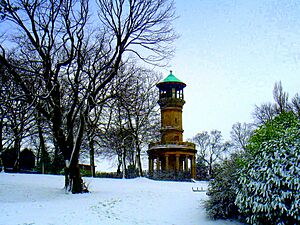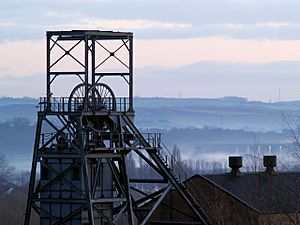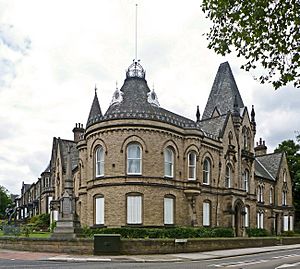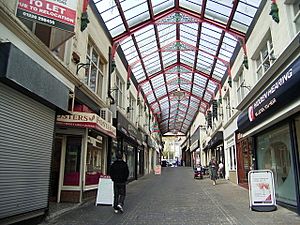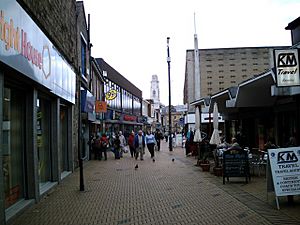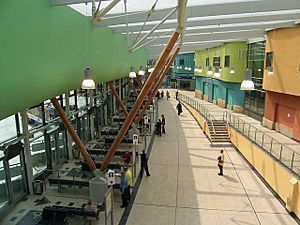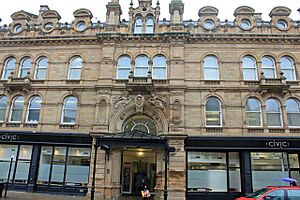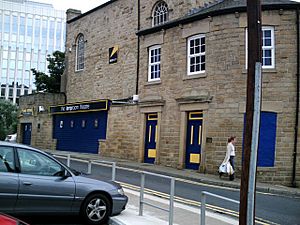Barnsley facts for kids
Quick facts for kids Barnsley |
|
|---|---|
| Town | |
|
|
|
| Population | 71,422 (2021 Census) |
| OS grid reference | SE3406 |
| • London | 175 mi (281 km) SSE |
| Metropolitan borough |
|
| Metropolitan county | |
| Region | |
| Country | England |
| Sovereign state | United Kingdom |
| Post town | BARNSLEY |
| Postcode district | S70, S71, S75 |
| Dialling code | 01226 |
| Police | South Yorkshire |
| Fire | South Yorkshire |
| Ambulance | Yorkshire |
| EU Parliament | Yorkshire and the Humber |
| UK Parliament |
|
Barnsley is a busy market town in South Yorkshire, England. It is the main town in the Metropolitan Borough of Barnsley. In 2021, about 96,888 people lived in the town.
Historically, Barnsley was part of the West Riding of Yorkshire. It is located between big cities like Sheffield, Manchester, Doncaster, Wakefield, and Leeds. Nearby towns include Rotherham and Huddersfield.
Barnsley used to be famous for making linen, coal mining, glass products, and textiles. The town's culture is strongly linked to its industrial heritage. It is well known for its brass bands, which started as social clubs for miners.
Contents
History of Barnsley
After the Norman invasion in 1066, many abbeys and priories were built in Yorkshire. New towns like Barnsley were also started.
The first mention of Barnsley was in 1086 in the Domesday Book. It was called Berneslai and had about 200 people.
In the 1150s, the town was given to the Pontefract Priory. Monks built a new town where three important roads met. These roads connected Sheffield to Wakefield, Rotherham to Huddersfield, and Cheshire to Doncaster. The original Domesday village became known as Old Barnsley.
The monks also built a church called chapel dedicated to Saint Mary and started a market. In 1249, Barnsley was given a special permission, called a Royal charter, to hold a weekly market and a yearly fair. By the 1290s, there were three annual fairs.
From the 1600s, Barnsley became an important stop for travelers between Leeds, Wakefield, Sheffield, and London. This helped trade grow, and inns and services did well. In the 1700s and 1800s, Barnsley became a major town for making linen.
The first passenger train station for Barnsley opened in 1840. Later, in 1850, the Manchester and Leeds Railway opened Barnsley Exchange station closer to the town center.
Barnsley became a municipal borough in 1869. In 1913, it became a county borough, which meant it managed itself more. The town grew bigger in 1921 and 1938, taking in nearby areas like Ardsley, Monk Bretton, and Carlton.
In 1908, a sad event happened at a public hall, now called The Civic. Many children were rushing to see a film, and 16 of them were hurt and died.
Barnsley has a long history of making glass. However, it is most famous for its coal mines. In 1960, there were 70 coal mines nearby. The last one closed in 1994. The National Union of Mineworkers still has its main office in Barnsley.
The famous writer George Orwell visited Barnsley in 1936. He wrote about the town in his book The Road to Wigan Pier. He thought the money spent on the Barnsley Town Hall should have been used to improve housing for miners.
How Barnsley is Governed
The Barnsley Town Hall is a beautiful building made of white stone with a tall clock tower. It opened on December 14, 1933. This building is where the local government for the Metropolitan Borough of Barnsley is based.
The County Borough of Barnsley was created in 1913. This meant it was run separately from the West Riding of Yorkshire. In 1974, Barnsley became part of the larger Metropolitan Borough of Barnsley. This new area included many other towns and villages like Penistone and Cudworth.
The Labour Party has always been in charge of the Barnsley Metropolitan Borough Council. After the 2012 election, the council had 53 Labour councillors, 5 from the Barnsley Independent Group, and 5 Conservative councillors. The council chooses a new mayor each year. On that day, there is a parade in front of the Town Hall to celebrate the new mayor.
Barnsley is divided into four areas for national elections. These are Barnsley North, Barnsley South, Penistone and Stocksbridge, and Wentworth and Dearne. Each area has a Member of Parliament (MP) who represents it in the national government. Currently, all these MPs are from the Labour Party.
Geography of Barnsley
Barnsley is located in the valley of the River Dearne. It is at the eastern edge of the Pennines hills, close to the Peak District in the west. The town sits on an area rich in coal, with sandstone from the Carboniferous period.
The town is about 12 miles (19 km) north of Sheffield and 17 miles (27 km) south of Leeds. It is also 9 miles (14 km) south of Wakefield and 32 miles (51 km) east of Manchester.
Areas and Suburbs
Barnsley has many different areas and suburbs. Some of these include:
- Ardsley
- Athersley
- Carlton
- Cudworth
- Dodworth
- Elsecar
- Hoyland
- Kendray
- Monk Bretton
- Pogmoor
- Royston
- Stairfoot
- Worsbrough
Barnsley's Green Belt
Barnsley is surrounded by a special area called a green belt. This area is protected to stop towns from growing too much and joining together. It also helps keep the countryside safe and encourages the use of old industrial land for new buildings.
The green belt helps keep the different towns and villages in the area separate. Larger communities like Cudworth and Dodworth are not part of the green belt. However, smaller villages and rural areas are included. The green belt was first set up in 1979.
The green belt also encourages outdoor activities. It includes places like the River Dearne valley, Worsbrough Mill Park, Locke Park, and Wentworth Castle and gardens. The Trans Pennine Trail for walking and cycling also runs through it.
Population of Barnsley
The 2011 census showed that Barnsley had a population of 91,297 people.
The 2021 census found that most people in Barnsley are White (95.5%). Smaller groups include Asian (1.4%), Mixed (1.1%), Black (1.0%), and other ethnic groups (1.0%).
Barnsley's Economy
Barnsley was once known for its linen trade. From the 1850s, many coal mines opened, especially in villages east of the town. Coal mining was the biggest industry until the late 1950s, when it started to decline. All mines in the area are now closed, with the last one, Goldthorpe Colliery, shutting in 1994.
Other important industries were wire, linen, and glass making. Today, only glass making remains, with one company still operating. The town's coat of arms shows a coal miner and a glass-blower, along with the motto Spectemur agendo, which means "Let us be judged by our acts."
Big companies in Barnsley include the online clothing store ASOS and Premier Foods, which makes Mr Kipling cakes. Other businesses include Ardagh Glass (bottle makers) and Symphony Kitchens. Many of these businesses are on industrial parks built on old coal mine sites. The town center is now focusing more on service industries.
In June 2024, the number of people without jobs in Barnsley was lower than the national average.
The western part of the borough is rural and stretches from the M1 motorway to the Peak District. This area has the market town of Penistone and attractions like Wentworth Castle and its gardens, Cannon Hall Park and Museum, and Wortley Top Forge.
Since 2002, Barnsley Council has been working on a plan called "Rethinking Barnsley." This plan aims to improve the town center. New projects include a transport hub, a cultural center, and new offices and homes. Business parks near the M1 motorway have also created more job opportunities. The Barnsley Development Agency leads the town's economic growth.
Town Centre Shopping
A large part of Barnsley town center was built in the 1960s. The area around Cheapside and May Day Green has the market and many well-known shops like Marks & Spencer and Boots. This area is being updated to make space for new shops and entertainment.
The Alhambra Shopping Centre, opened in 1991, has stores like Next and Primark. Other important shopping streets include Queen Street and Eldon Street. The Victorian Arcade has many independent and designer shops. The town also has many pubs and bars. There is a cinema called Parkway Cinema Barnsley on Eldon Street.
Outside the town center, you can find larger shops and supermarkets like Asda and Morrisons.
A new shopping center development in the town center started in late 2015.
New Developments in Barnsley
Barnsley town center is changing with many new projects:
- The new Barnsley Interchange (a combined rail and bus station) is finished.
- The Digital Media Centre is also completed.
- Gateway Plaza at Town End is finished.
- Experience Barnsley is a new museum and archives center in the Town Hall. It tells the story of Barnsley's people. This project received nearly £3 million in funding.
- Barnsley College's new A Block opened in September 2011.
- A new area called The Glass Works is now complete. It includes the town's market, a 13-screen Cineworld cinema, a bowling alley, and high street shops.
Landmarks to Visit
Here are some important landmarks in Barnsley:
- Barnsley Town Hall: Now home to Experience Barnsley, a museum about the local area.
- Cannon Hall: A museum, park, and gardens in Cawthorne.
- Cannon Hall Farm: A working farm and fun place to visit in Cawthorne.
- The Civic: An old building from 1877 that now has a theatre and art gallery.
- Locke Park: A lovely park for relaxation.
- Monk Bretton Priory: Old ruins of a monastery in Monk Bretton.
- Oakwell Stadium: The football ground for Barnsley Football Club.
- Wentworth Castle: A country house and gardens in Stainborough.
- Barnsley Main: A historic building that was once a coal mine pithead.
Barnsley was also home to the first bottle bank in the United Kingdom for recycling glass. It opened on August 24, 1977.
Getting Around Barnsley
The main place for transport is Barnsley Interchange. This is a combined train and bus station that opened in 2007. It was one of the first projects of the Remaking Barnsley plan.
Bus Services
Stagecoach Yorkshire runs most of the bus services in Barnsley. Buses go to and from Barnsley Interchange.
Train Services
Northern Trains provides passenger train services. Trains usually run every hour:
- Northbound: Two fast trains to Leeds (about 35 minutes). One slower train to Leeds via Castleford. One train to Huddersfield.
- Southbound: Four trains to Meadowhall Interchange and Sheffield. Some of these continue to Chesterfield & Nottingham or Retford & Lincoln.
Train services are less frequent in the evenings and on Sundays.
Other train stations in Barnsley include:
- Dodworth railway station: West of the town center.
- Darton railway station: In north Barnsley.
Air Travel
The closest airport to Barnsley is Leeds Bradford Airport, which is about 31 miles (50 km) away.
Education in Barnsley
Barnsley College has several sites around the town center. The University of Huddersfield also has a campus in Barnsley called University Campus Barnsley.
All 14 secondary schools in Barnsley were replaced by new academy education centers. These new schools are called 'SuperSchools' and were built as part of the Building Schools for the Future program.
Famous People from Barnsley
Many notable people come from Barnsley:
- Bethany England (born 1994): A professional football player for Tottenham Hotspur and the England national team.
- Brian Glover (1934–1997): An actor and wrestler who grew up in Barnsley.
- John Stones (born 1994): A professional football player for Manchester City and the England national team.
- Lauren Tate (born 1997): A singer, songwriter, and producer, known as Delilah Bon.
- Ian McMillan: A poet and writer, often called the "Bard of Barnsley."
- Harold "Dickie" Bird: A famous cricket umpire.
- Dr Joann Fletcher: A well-known Egyptologist.
- Kate Rusby: A popular folk singer.
- Graham Ibbeson: A sculptor.
- Katherine Brunt: A famous cricketer.
- Katherine Kelly: An actress.
Culture and Arts
Theatre in Barnsley
The Civic is a performance venue in Barnsley town center. It is a historic building from 1877. It used to be called the Harvey Institute and hosted many types of entertainment, including shows and films. It also had a public library and shops.
The Civic reopened in 2009 after a big renovation. It now has a theatre and a public art gallery. It has hosted famous acts and touring art exhibitions from places like the V&A in London.
The Lamproom Theatre has four theatre companies and puts on many plays. The Academy Theatre also hosts performances from comedy to musicals.
Museums and Galleries
Barnsley Council runs five museums:
- Elsecar Heritage Centre
- Cannon Hall
- The Cooper Gallery
- Worsbrough Mill
- Experience Barnsley (opened in the Town Hall in 2015)
Other museums include the Darfield Museum and the Cawthorne Victoria Jubilee Museum. Historic sites include Wortley Top Forge, Wortley Hall, Wentworth Castle, and Monk Bretton Priory.
HIVE Gallery is a modern art gallery in Elsecar Heritage Centre. It shows art from new artists and also from nationally and internationally known artists.
Music Scene
Barnsley is famous for its brass bands. These bands started as social clubs for miners. The Grimethorpe Colliery Band, located near Barnsley, is one of the most famous brass bands in Britain. It became well known from the film Brassed Off.
Barnsley also has a lively rock and hip hop music scene. In the 1980s, bands like Saxon (metal) and Danse Society (Goth) became popular. Alex Turner and Matt Helders from the band Arctic Monkeys studied music at Barnsley College.
There are several live music venues in Barnsley, such as The Underground and The Garrison. Barnsley also hosts Barnsley Live, an annual music festival featuring local bands.
In December 2023, a Christmas carol written by local musician Arthur Godfrey in 1933 was found again. It was re-recorded to celebrate the 90th birthday of the Town Hall.
Other Arts and Media
Ian McMillan, known as the "Bard of Barnsley," writes a column in the Barnsley Chronicle. He is also often heard on BBC Radio 4.
Locals sometimes call Barnsley Tarn.
The 1969 film Kes by Ken Loach was filmed in villages around Barnsley, like Lundwood and Monk Bretton. It used local actors. His 1977 film The Price of Coal was also set in the Barnsley area.
The creators of the 2024 adventure game Thank Goodness You're Here! are from Barnsley. The game's setting, Barnsworth, is based on the town.
Local Media
You can watch regional television from BBC Yorkshire and ITV Yorkshire.
Local radio stations include BBC Radio Sheffield, Greatest Hits Radio South Yorkshire, Heart Yorkshire, Capital Yorkshire, and Hits Radio South Yorkshire.
Local newspapers that serve the town are:
- Barnsley Chronicle
- The Star
- We Are Barnsley (an online newspaper)
Twin Towns
Barnsley is twinned with:
- Schwäbisch Gmünd, Germany
- Horlivka, Ukraine
Sports in Barnsley
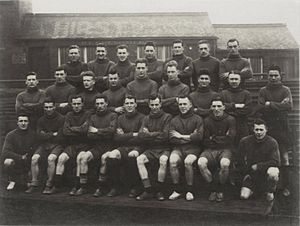
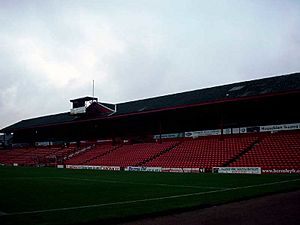
Barnsley F.C. is the town's professional football team. They play at Oakwell Stadium, which is just outside the town center. The club has had ups and downs, including a brief time in the Premier League in the late 1990s.
There is also a women's football team called Barnsley WFC.
Speedway racing used to take place near Barnsley. Greyhound racing was also held at Dillington Park Stadium for many years.
Rugby league is played by several clubs in the town. The Dearne Valley Bulldogs are one of the teams. Barnsley Broncos play in a summer competition.
Shaw Lane is a big sports complex in Barnsley. It hosts cricket, rugby union, squash, bowls, football, athletics, and archery. Barnsley CC (Cricket Club) and Barnsley RUFC (Rugby Union Football Club) are based there.
Barnsley also has a high-standard badminton league and a nationally recognized running club called Barnsley Harriers.
There are several cycling clubs in and around Barnsley, like Barnsley Road Club and Birdwell Wheelers. These clubs cover many different types of cycling.
Freedom of the Town
The "Freedom of the Town" is a special honor given to people, military units, or groups who have done great things for Barnsley.
Individuals Honored
- Henry Horsfield (Town Clerk): 1912
- Charles Wray (Alderman and former Mayor): 1921
- Lieut-Colonel W. E. Raley (Alderman): 1921
- David Lloyd George (Prime Minister): 1921
- Harold "Dickie" Bird: 2000
- Rita Britton: 2000
- Lord Mason of Barnsley: 2007
- Dr Joann Fletcher: 2016
- Ian McMillan: 2016
- David Moody Lord Lieutenant of South Yorkshire: 2016
- Kate Rusby: 2016
- Graham Ibbeson: 2022
- Katherine Brunt: 2022
- Patrick Murphy (artist and designer)
- Katherine Kelly: 2022
Military Units Honored
- The Light Dragoons
- The Yorkshire Regiment
Organizations and Groups Honored
- The ICU Staff at Barnsley Hospital: 2022
See also
 In Spanish: Barnsley para niños
In Spanish: Barnsley para niños







